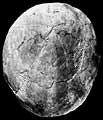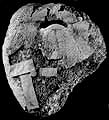The Echinoid Directory
Waurnia McNamara & Philip, 1984, p.341
| Diagnostic Features |
|
|---|---|
| Distribution | Late Oligocene, Australia. |
| Name gender | feminine |
| Type | Pericosmus nelsoni McCoy, 1882, p. 17, by original designation. |
| Species Included |
|
| Classification and/or Status |
|
| Remarks |
|






